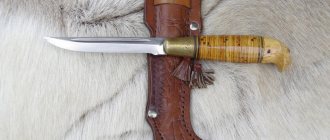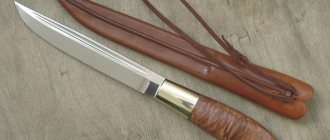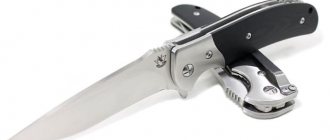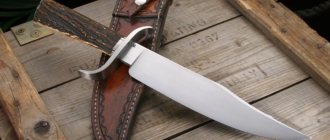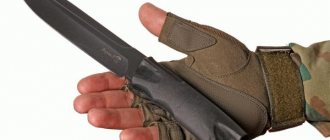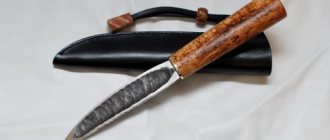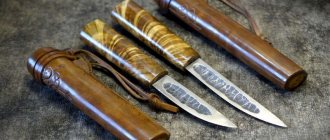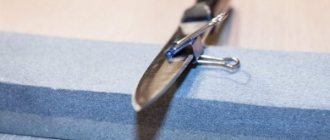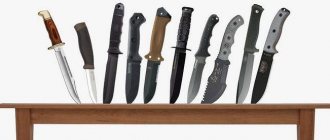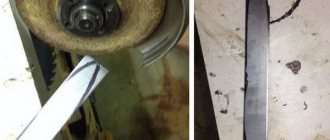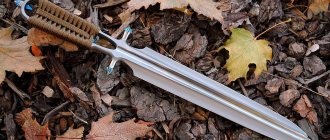The best models from well-known manufacturers and related options
The most valuable are the guns from Fiskars and Hackman.
They are found on sale much less frequently and are expensive - up to 20 thousand rubles. 1 of 2
puukko from Roselli
puukko from Marttiini
Those interested in puukko usually do not ignore the leuku, a larger Scandinavian hunting knife. This type of implement can be found at Martini and Roselli
Finnish Roselli
Finnish puukko Roselli knives are known to weapon lovers all over the world, as they differ in:
- High quality steel. For blades, use carbon Krupp W75, high carbon UHC, Roselli Wootz or Damascus. They are sharpened by hand, and the blade can not only cut paper, but also shave.
- Comfortable handles made of Karelian birch. They are well polished, impregnated with linseed oil, and heat treated. Thanks to this, the knife fits well in the hand, does not slip, and does not get cold. And the handle remains durable, despite the active use of the product in any conditions. The butt plate is usually rounded, that is, the gun can be held with a “Finnish grip” with the emphasis on the palm.
- Sheath made of durable leather. Inside there is a plastic cover that prevents the blade from damaging the base material. A convenient suspension makes carrying the gun hassle-free.
Watch the video about Finnish knives from Roselli:
The length of the puukko blade from Roselli is 85-102 mm, the handle is 110-125 mm. These knives are well balanced, which also makes them easier to use. You can buy a gun for 6-11 thousand rubles, there are copies priced at 60 thousand rubles.
Puukko and leukko
Finnish knives puukko and leukko are not exactly the same thing, although the latter is called by some a variant of puukko. And yet leuku has its own characteristics:
- Larger size. The length of its blade is 13-21 cm, width – 3.5 cm. The handle of the weapon is significantly shorter than the cutting component.
- A different blade shape. Leukko also has a straight spine and a raised blade line. But, unlike the puukko, the blade expands slightly in the area between the base and the tip, more precisely in the place where the sharp edge changes direction.
Leuku are produced by the same companies as the famous puukko models, although they originate from Lapland.
Martini big
Finnish puukko knives of the Martini Big Lynx series are one of the popular and inexpensive varieties of tools of this type, released for the 110th anniversary of the founding of the company. The blade has a length of 11 cm and a traditional shape, made of X46Cr13 steel with a hardness of HRC 56-57.
Marttiini Big Lynx
The handle of the knife is made of Karelian birch, its size is 12.5 cm. This part is very ergonomic, thanks to the recess for the finger at the base. The backplate is slightly bent downwards, which provides an even more secure hold of the tool in the hand.
The weapon comes with a leather sheath. They have an interesting shape - the tip is raised, there is a tassel-type detail on it. Closer to the entrance of the scabbard there is an image of the founder of the company and its logo. The cost of the gun is 5-7 thousand rubles.
Puukko is a knife that is convenient for many and beautiful in its simplicity, but sometimes you need to get used to it. When choosing, you should be guided not only by the reviews of others, but also by your own feelings. And, of course, it is better to buy a weapon from a well-known company so that it serves for a long time and does not lose its qualities.
Just a knife). Knife fighting for dummies.
Knife fighting (for dummies)
So as not to forget. The instructor said three important rules: If an enemy is standing in front of you and you understand on a subconscious level that he wields a knife, then fuck off.) The safe escape radius is half a kilometer.
The second rule says: A knife, like in the movies, is not thrown towards a sound; in general, people don’t throw a knife at a target in memory. Because when you throw a knife, you lose your weapon. The lethal distance for throwing a knife is 5 meters and you only need to hit the throat. Evaluate your skills, + adrenaline + uncertainty + enemy weapons. Having assessed all these criteria, feel free to throw the knife)
Third rule: If you want to get a pistol, then you need a knife. If you need a machine gun, then you need to get a pistol, etc.)
Let's look at what you need to know to get a gun.)
The catalog of feature films on knife fighting is scarce; so far I have found two films: Hunted and A GRANDE ARTE from 1991.
These two films show the essence of knife fighting and the degree of danger that knife fighting specialists pose.
Knife from the film Hunted.
Tracker-Weight: 454 g Overall length: 302 mm Blade length: 159 mm Blade thickness: 6.35 mm Blade: Carbon steel 1095 Steel hardening: HRC 58 Blade coating/finish: Traction Coating Handle: Micarta Sheath: Kydex
For throwing knives.
The knife is thrown either with the handle in front or with the blade. It all depends on the distance. The farther the target, the closer the hand is to the handle of the knife.
Pros measure the meter to the target with a finger on the knife blade. For example, 1 meter = the thickness of a finger from the tip of the knife blade. In practice, it is rare that a knife enters a training wooden shield from one meter, but the instructor said so and clearly demonstrated by throwing 3 knives into the shield with 100% hitting the target.
KNIFE THROWING . Everyone knows from movies that throwing a knife at a person can kill him. Our scouts in old films “about the war” famously shot down German sentries, hitting them in the neck from about fifteen meters away. In fact, the main distance for throwing a knife is 5-6 steps, which is 3.5-4.5 meters (standard “step” is 71-72 cm). Only in this case the enemy receives a blow without having time to dodge, deflect, crouch, fall, or close.
The greater the distance to the target, the more difficult it is to calculate the trajectory and the required number of rotations of the knife along the longitudinal axis. And on the contrary, if the distance does not exceed 5-6 steps, then the knife, after leaving the hand, only manages to make half a turn in the air and enters the point of destruction with its tip. Further 10 steps the circus performers throw the knife in the arena. The point of throwing is not only to prevent the enemy from getting closer. The damaging force of a knife when thrown is almost twice as great as when thrusting with a hand. Special experiments have shown: by thrusting a knife into a shield made of boards, fighters pierce the wood by 16-17 mm, and when throwing - by 27-28 mm!
This clearly demonstrates a revolution in the understanding of knife throwing - Scanf, I think that many are puzzled by this particular throwing method.)
A throwing knife differs from a regular knife in several ways. The most important difference is that its center of gravity is exactly in the middle or shifted to the tip. In addition, a special throwing knife usually has an extension of the blade towards the tip. The point is well sharpened, while the blade from the flare to the handle can remain dull. There is no guard so as not to slow down the flight. These knives themselves are usually made by stamping; the handle - in the exact sense of the word - is most often absent. It is replaced by a notch. Often, on the side where the handle should be, a wide slot is made in the metal. It’s more comfortable to hold it this way, and it’s easier to ensure a shift of the center of gravity towards the tip. Of course, you can throw an ordinary knife (dagger, cleaver, stiletto, bayonet), as long as it satisfies the basic requirement: the blade is at least a little heavier than the handle.
Throwing knives
There are various ways to throw a knife - from the side, from below, backhand, lying down, from behind cover. But the simplest, at the same time the most powerful and effective - throwing while standing, from behind, with a grip on the blade. To do this, you should take the knife blade with your right hand so that the handle is directed forward, with the blade to the left, the thumb lies on top of the knife, and its axis is a continuation of the axis of the forearm. The remaining fingers hold the knife from below, without touching the tip.
Take a left-sided fighting stance: right hand in front of the chest, its forearm vertical (i.e., the arm is bent at the elbow at a right angle), the handle of the knife is directed upward. The left arm is slightly bent and extended forward. Then, bending at the waist, swing your right hand up and back over your shoulder without bending your wrist. Keeping the forearm, thumb and blade on the same line, sharply straighten at the waist and straighten your right arm, without additional force with your hand, send the knife with the handle to the target. The blade must be released at the moment the arm is fully straightened along the aiming line.
Throwing a knife over the shoulder
The main requirement that must be observed when throwing a knife is not to allow the hand to whip and not to let the hand fall below the level of the target. You also can’t “get hung up” on the desire to hit the target at all costs. The body should be relaxed, knees bent, breathing down (breathe not from the chest, but from the stomach), and at the moment of the throw, exhale lightly. With this throwing method, a knife 20-25 cm long makes one half-turn at a distance of 3-5 meters.
The accuracy of hitting with the tip of the blade largely depends on where you hold the blade. The closer the thumb is to the handle, the greater the distance to the target should be, and vice versa. Each fighter determines the best throwing distance and place for gripping the blade during training using trial and error methods. To defeat an enemy at a distance of less than three meters (2-4 steps), you can throw the knife with the blade forward. In this case, it is held by the handle, blade to the left, thumb on top. The starting position and throwing technique are similar to throwing the handle forward.
When practicing the technique of throwing a knife, you need to pay attention to the position of the weapon in your hand and the distance to the target with each throw. If the blade does not stick into it, but hits flat, change the location of the thumb, shorten or increase the distance. The average number of training sessions to develop the skill of hitting a target from a standing position 3-5 meters from the target is 25-30 (classes every other day), 30-35 minutes each training session. Longer training does not make sense, as severe fatigue of the shoulder joint occurs. Then you need to complicate the training. In particular, move on to throwing several knives in a row at targets located in a fan at different distances - from two to five meters. In addition, you need to learn the technique of throwing on the move, without stopping to throw.
Throwing knives in several directions
A little about knife fighting, since the instructor spent only half an hour on the knife and in the future there will be a wide overview, the article will be supplemented with pearls.
In the previous post about medical care Providing first aid for bullet, knife and shrapnel wounds (For dummies) it was described about the arteries and veins that circulate in the human body. The goal in a knife fight is to damage them and, if possible, cut the tendons. If 2 liters of blood are lost, the enemy dies within 1-2 minutes. Due to internal blood pressure, blood from the arteries can flow like a fountain and 1-2 liters can leave the body within 1 minute.
Rating system
- Clear victory (4 points) for:
- Neck knife cut
- Gaining four points during a fight
- Half a win (2 points) for:
- Head cut
- Cut or puncture to the abdomen and back
- Cut or puncture on leg (thigh to foot)
- Loss of weapons by the enemy
- Quarter of victory (1 point) for: If clicking on the VKontakte video player does not start, then a link will appear in the center of the video, watch in high quality, click.
- cut or puncture of the arm (from shoulder to hand) and chest.
- Maneuver consists of movements aimed at performing certain tactical tasks, which in turn are necessary to achieve a result - avoiding a fight with a minimum of losses or defeating the enemy(s).
The maneuver is divided into: • Maneuver on the legs (the body moves) • Maneuver with the body (slopes), the body and head move to avoid being hit by the enemy’s actions
Safety distance is an individual parameter of a fighter; in fact, it is a distance that allows him to react in time to the actions of the enemy (the enemy’s limbs). But practice differs from theory in that we are obliged to take into account DYNAMICS, i.e. movements and anthropometric data, in short, the structure of a person.
What is special: 1. In the process of moving forward, a person can take a deeper step than back, and even less sideways than back. 2. The peculiarity of reaction forward, backward and sideways (left-right) is an individual parameter depending on the length of the leg, flexibility in the joints, balance, dexterity, finally. 3. Taking all this into account, we get a non-circular structure of the safety distance in the process of movement, i.e. a forward step will be longer than a backward or sideways step. 4. We get an oval (distance of movement), and not a circle and the understanding that it is difficult for a person to take more than two steps back and he will most likely stumble, falling sideways goes 1 step and then a loss of balance begins, and the depth of entry - moving forward too not infinite, but long enough, which introduces priority in taking into account distance control along the front
Knife grips:
To confront two armed opponents, you need to line them up in one line, for example, if both are right-handed, then you need to go behind the right shoulder of the nearest enemy, and the second will interfere with the first, since he will need to get around his partner to reach you.
- The art of wielding a knife takes 1-2 years to learn, there are a lot of techniques. I present to your attention a video on the technique from evil guys on YouTube. If new information appears for dummies, I will add to the article.
Let's look further)
There is a cool Finnish film on training saboteurs. Old Finnish self-defense education film
A little more video.
Interceptions with a knife . It's not so much show-offs and stunts, it's drill training with weapons. In our case, this is a warm-up with a knife before starting training.
A little about tuning the knife.
Now that you've watched the video, you can rest.)
Click like and you will be GREATLY HAPPY for this!)
Recommendations
The price of replica NKVD knives on the modern market ranges from 150-200 dollars (9-12 thousand rubles). The final cost is affected by age, equipment and material of manufacture. Early copies are valued higher, as they are considered to closely imitate the original finca. Initially, the blade in question belonged purely to specialized military weapons. Now such products are usually positioned as collectible or souvenir exhibits. It is recommended to purchase the original in the presence of an experienced antiquarian. It will help not only determine the authenticity of the model, but also its real value.
Is it possible to make a Finnish NKVD knife 1935 with your own hands?
The product can be made with your own hands so that you get an NKVD Finnish knife from 1935: you need to have a sheet of good steel, for example, grade 95X18, for the handle - a wooden block, and the guard and pommel are made from pieces of brass. You will need a set of discs of different diameters and with belts of different abrasiveness, a vice, and welding. The whole process consists of several stages:
- A drawing is made on paper or cardboard, possibly in two projections.
- On its basis, a cardboard template of a blade with a shank is cut out.
- It is fixed on a steel sheet, outlined and the workpiece is cut out along the lines using a disk machine.
- It is leveled using a flat grinder.
- Using a disk, draw a valley along the butt.
- The runs are made on a large disk with a diameter of 40 cm using a coarse 40-N abrasive.
- The next stage is hardening the blade in a forge, followed by cooling in oil and tempering.
- The bevels and blade are treated with a finer grit disc to level and polish.
- The final polishing of the blade is carried out first on a disk with a 4-N fine abrasive tape, and then on felt and GOI paste.
- The finished guard and butt are processed on a milling machine so that they fit the size of the blade and tang.
- The working part of the blade is wrapped with masking tape.
- A polished guard is placed on the shank.
- Holes are made in it for fastenings for a rod with a thread for a nut; it can also be welded.
- To make the handle, a birch block is turned and polished.
- A hole is made in it with a diameter corresponding to the thickness of the shank.
- In a small container, mix epoxy resin with hardener.
- The composition is coated with the place where the blade connects to the guard, the rest of the liquid is poured into the hole in the handle blank.
- The shank is also inserted there; its threaded tip should stick out from the other side of the wooden block.
- A nut is screwed onto it to secure the structure.
- The nut and pin are covered with a brass cap, which will be held in place by the epoxy mixture.
- The knife is placed in a vice and left to dry for a day.
- The handle is ground on a Grinder machine using sandpaper.
- To ensure smoothness, it is sanded by hand, clamped in a vice.
- The pommel is polished, including using GOI paste.
- The wooden part of the handle is treated with beeswax.
Watch the video of the complete production of the “NKVD Finka” knife:
What prompted the creation of scout knives?
The emergence of various types of firearms and equipment gradually relegated knives to the background, and this clearly affected the equipment of the Soviet troops, and in the most unfavorable way.
It became characteristic that by the 40s of the last century (or rather, during the period of hostilities between the Soviet Union and Finland in 1939), there was no standard knife for equipping a Soviet soldier (the bayonet that was attached to the Mosin rifle does not count: it was intended only for stabbing wounds). At the same time, the soldiers certainly needed an assistant: to cut bread, trim wood, cut rope and for many other needs, not excluding, of course, one of the main functions - self-defense, protection from the enemy.
The direct opposite was the enemy’s combat arsenal - Finnish soldiers, especially those who went on reconnaissance missions, had to have edged weapons.
The leadership of the Soviet Army, taking into account the unpleasant results of military clashes with the Finns for our side, came to the conclusion that soldiers, in particular those performing reconnaissance operations, needed to strengthen their combat arsenal. Consequently, it was decided to add one more component - a special reconnaissance knife, and the blade, which was used by the enemy, became a completely suitable idea for the development of the first Soviet reconnaissance knife, HP-40 (the digital indicator in the stamp indicates the year of manufacture - 1940).
Design Features
For any bladed weapon, the main characteristic is the effectiveness of practical use. The finka is precisely the kind of weapon that can be both effective in combat and useful in everyday life. The blade of the traditional Finnish version is short and pointed on one side. However, this blade length makes it easy to use the knife for cutting branches and sharpening stakes. The product is very convenient as a kitchen utensil and can be used for cutting game. The blade is equipped with a thick spine, which allows you to apply additional physical force. The block or handle of the finka can withstand a blow from a log or a hammer to the butt.
For the manufacture of knives, weapon steel with a hardness of 58 units on the Rockwell scale is usually used. A Finnish hunting knife, made using traditional ancient technology by Finnish blacksmiths, is made from a worn-out scythe. The metal in this case is soft and ductile, amenable to cold forging. The manufacturing technology of traditional Puukko-Finnish knives was as follows:
- worn-out braids are collected in a bag (2-3 pcs.);
- when heated, the package is forged until monolithic bars are obtained;
- the finished bars are riveted into narrow thin metal strips;
- then pieces of steel are cut to fit the size of the blade;
- the strip is forged and turned to the shape of the blade and shank;
- the handle is mounted on the blade.
Today, for the manufacture of various versions of Finnish knives, high-carbon steel is mainly used, where nickel and chromium are present as alloying additives. Nickel increases the metal's resistance to corrosion, and chromium makes the material more resistant. In ancient recipes for making Finnish knives, they tried to use durable steel. Today, the edged weapons market is dominated by cheap grades of steel, which are used for the mass production of knives of dubious quality.
High-quality steel allows the blade to maintain its sharpness for a long time. Proper and competent care of the blade will prevent rust from occurring.
Design features
The shape of the Finnish knife has come to us since the Bronze Age, and essentially has not changed. The traditional Finnish blade is called a puukko, which in Finnish means “equipped with a wooden handle.” Over time, various variations of the model appeared, but the main features remained constant.
The main one is efficiency in application. The length and width of the size of the Finnish knife in the drawings could be slightly modified. Main characteristics of the Finnish:
- The blade is straight, small, made of steel (Rockwell hardness 54 units), slightly longer than the length of the palm, sharpened on one side. Its dimensions of 125 x 20 x 4 mm allow the cutting part to be significantly more resistant to physical stress.
- The butt is wide, straight, in line with the blade, and has a thickening in the center - this allows it to fit more comfortably in the palm. Also withstands significant impacts.
- A distinctive feature is the heel - the unsharpened part of the blade between the guard and the handle. It allows you to control the nature of the cut by placing your index finger in a given place.
- Mounted handle, 150-200 mm long (total knife length up to 300 mm). The classic oval version of the handle is made of birch (preferably birch burl) from the Karelian Peninsula. Thanks to the mandatory wax (bee) and oil impregnation, the handle becomes more durable, does not slip, and does not cool the skin of the palm. Special indentations for the fingers - a Finnish grip - allow you to securely hold the blade in your hand. The edge of the handle has an extension (in the form of a mushroom cap), making it comfortable to hold even with mittens. The connection between the handle and blade is secured with a metal border.
- The sheath is most often made of calfskin, and there is a fastener for a belt. The mouth of the sheath is clearly adjusted to the size of the blade. Taking out the fin is convenient and quick.
Features of the shape of the knife are due to the harsh climate of the north:
- the wooden (not metal) handle can be safely taken by hand in cold weather;
- the oval, large shape of the handle is easy to feel even in a mitten;
- The slopes, brought to zero from the middle of the butt, are designed for convenient planing of wood.
Finks change over time. New decors appear:
- inserts between the blade and handle made of gold or brass;
- handle heads in the shape of various figures;
- engraving on the blade;
- various decorations of the scabbard.
What is so special about the NKVD Finnish knife?
The NKVD Finnish knife or any other knife belonging to this category is known for its practicality and versatility. Products mainly have fixed blades, but there are also folding models. Finka differs from other knives:
- small sizes - 22-24.7 cm;
- the presence of a stop or S-shaped guard;
- a narrow blade with a beveled spine, 10.6-12.5 cm long;
- valleys running parallel to the blunt part of the part;
- a rounded or slightly curved handle with a non-slip surface and a mushroom-shaped pommel.
A traditional knife differs from a Finnish knife in that it is designed to solve narrow problems. Finnish, despite its small size, is suitable for self-defense, use at home, fishing or hunting. Design features make it safer for the owner.
The Finnish knife looks like a military weapon, although in most cases it is not. His most famous replicas belong to the category of tourist, hiking or gift items.
Blade dimensions, handle
Drawing
The dimensions of the Fink knife vary from 22 cm to 24.7 cm. The main parameter is the length of the blade, which for the classic model is 12.5 cm, but can be less - up to 10.6 cm.
The width of the part should be no more than 2 cm, and the thickness - up to 0.4 cm. This is a characteristic feature of the weapon - a narrow and short blade with a thin tip. The part is of the clip point type, that is, it has a bevel on the butt. Or is he straight? There are valleys along the butt on both sides, making the blade lighter and more maneuverable.
The weapon has a guard or, at a minimum, a limiter that prevents your hand from slipping onto the blade. Models with a bolster can be held with a Finnish grip, that is, resting on the palm. Some weapons have a “heel” in front of the guard - an unsharpened section of the blade. Thus, with a direct grip, the index finger lies on the blade, but the skin cannot be injured. But the direction of the cut is perfectly controlled.
Drawing
The handle of the product was originally wooden. But modern models use bakelite and other synthetic materials. The shape of the part is round, sometimes tapering towards both edges or thickening towards the end. The pommel comes in the form of a fungus and can be made of brass or another metal alloy.
Materials
Previously, the blades of Finnish knives were made from 2-3 worn braids. They were formed into a package, that is, folded, heated, and forged into a monolithic piece. Sheets were then made from it, blanks were cut out, processed and mounted on a wooden handle.
Modern replica guns are made of high-carbon steel with a hardness of 58 HRC, with the addition of nickel and chromium. They are durable, remain sharp for a long time, and with good care are not subject to corrosion. There are also cheaper models with stainless steel blades.
The handles of souvenir knives are made of Karelian birch, animal horn, with cupronickel inserts and leather additives. The same part can be created from hornbeam with brass, a polymer material.
Is it a bladed weapon?
In the photo there are Finnish knives that are freely available (not being weapons).
The original Finnish knives are edged weapons (KW), as they have the appropriate technical parameters, which are specified in GOST R 51215-98:
- handle with finger grooves;
- blade length is more than 9 cm;
- butt thickness from 0.24 cm;
- the angle of convergence of the butt and blade is less than 70 degrees;
- the presence of a stop-limiter.
But it is difficult to find such a weapon for sale, and it is very expensive. To own, you must obtain permission. And Finns that are freely available are not XO, since their size and characteristics do not fall under this definition. Such knives are classified as tourist, camping, or souvenir knives, as stated in the certificates attached to them.
What does the history of the Finnish woman tell?
This knife was very popular at different times. Famous writers Bulgakov and Yesenin mentioned the Finnish knife in their works. Among elements of the criminal world there was a special attitude towards him. The Finnish knife was taken as the basis for the knife of security officers and Soviet intelligence officers. The history of the appearance of the Finnish knife is very unusual. The fact is that there are 2 stories of its appearance
- The first story confirms that it was indeed invented in Finland. This knife was extremely popular among the Finns. It was used as a silent weapon in independence skirmishes. It was also used for hunting and for various household chores. Only in Finland they called it not “Finnish knife”, but “Puukko”.
- The second version refutes the Finnish origin of the knife. The knife was designed and manufactured by American. It was called the "Fink knife".
This knife quickly gained popularity for a reason. It was comfortable and gave its owner a certain chic and status. The first peak of its popularity came in 1917. Back then, knives were not considered edged weapons. And according to the issued Decree “On the surrender of weapons”, it was the only one that could be carried with you. Banditry flourished. And the Finnish knife was used in numerous fights between hooligans and bandits.
Finks were freely available until 1935. But then a law was passed prohibiting the carrying of Finnish knives. Now the “Finnish” had the status of a bladed weapon. But some of the criminal world still carried knives, increasing their authority. Finks were also made by prisoners in prisons themselves. By the handle of the knife one could identify its owner. Nowadays, Finnish knives are very rare. They can be found in museums or private collections. But sometimes they are produced in limited quantities. Most of them were destroyed in the 90s.
The best puukko models
Currently, you can buy both traditional puukko knives and numerous replicas. On the one hand, a traditional knife looks distinctive and original, but on the other hand, you need to get used to the Finnish grip. Modern companies and private knife makers will make a knife taking into account any wishes. Handles made of ebony and other valuable types of wood are extremely popular now.
The best knives are considered to be those produced by Martini, Roselli and other famous knife brands that have been producing puukko knives for many years.
Author of the article:
ULFHED
I am interested in martial arts with weapons and historical fencing. I write about weapons and military equipment because it is interesting and familiar to me. I often learn a lot of new things and want to share these facts with people who are interested in military issues.
The history of the creation of the knife and the appearance of its name
The Finns are considered to be the creators of the knife, although there is another version according to which blades began to be imported to Finland from the Germans through Sweden. Historians can dispute this fact for a long time, but the main thing remains indisputable - the inhabitants of the Scandinavian countries highly appreciated the Finnish woman.
For residents of a country where hunting and fishing are developed, a knife of this configuration was simply necessary. Its small size and convenient use made it very popular, first among hunters, and then among the entire population.
During the Russian Empire, the Principality of Finland was part of the state from 1809 to 1917. Before that, it belonged to Sweden. The policy of disarmament of the indigenous population was carried out regularly and had a depressing effect on the people. The 19th century was marked by the liberation movement, and the Finnish knife culture became its personification. The Finnish guys who controlled residential settlements and villages were fighters for a free life and robbers at the same time. More often these were the heirs of the owners of large farm houses. Their distinctive feature was knives with stacked handles. All other Finns, from early childhood, also always carried traditional knives.
History of creation
The prototype of the Vachin finka was the national Finnish blade, known as the “pukko”. Over time, the Soviet version of the knife improved, acquiring specific characteristics that the Scandinavian ancestor did not have. The official history of the existence of Finnish women ended in 1935, when the carrying, manufacturing and sale of this type of bladed weapon was banned at the legislative level.
The original Vachin finca was designed and created in the 30s of the last century. The model was made for special units of the NKVD, which needed reliable and compact combat knives. Schemes and drawings were created on the basis of short Finnish national knives, which were designed by Pontus Holmberg. Since the creator was from Sweden, the blades were initially classified as the “Norwegian” type of blades.
Finnish puukko knife: description
The traditional Finnish puukko knife has the following characteristics:
- universal blade 10-15 cm with a straight spine, without fullers;
- a wooden barrel-shaped handle with a smooth surface, which is smaller in size than the cutting part;
- forged bolster separating the blade from the handle;
- a small back, which can be in the shape of a mushroom, in the shape of a dog’s head, slightly lowered or rounded.
Initially, it was a household and hunting knife, made from steel that was at hand at the blacksmith. But the Finns had to use the weapon in the struggle for independence, first from Sweden, then from Russia, in the war with the USSR. In the Union, other versions of the puukko were created - the bandit finka and the Finnish army knife.
Dimensions of a real knife
Traditional dimensions of a real puukko knife:
- blade 10-15 cm long, the most common size is 12-13 cm;
- its width is 2-2.5 cm;
- handle 11.5-13 cm long;
- its width in the most voluminous place is 3-3.2 cm;
- handle top – 1 cm.
The blade has a straight spine; the slopes to the blade should be of the Scandinavian type. For its manufacture, powder, Damascus, and carbon steel are used.
Puukko knife drawing
The barrel-shaped handle is made of wood, usually birch, and impregnated with oil. It is separated from the blade by a forged bolster. The pommel of the handle can be in several versions:
- slightly bent down;
- blunt with metal frame;
- with a convex “ridge”;
- with the outline of a mushroom cap;
- with the image of a dog's head.
The puukko also has a sheath made of leather or birch bark. In the first option, there is a wooden cover that protects the main material from damage.
The best Puukko models
The sheath is quite long, so that a significant part of the handle is hidden in it. They are also dense, narrow, and the knife is held in them due to this quality. The scabbard has a suspension that allows you to attach the weapon to your belt.
Origin and history of the old hunting knife
The oldest puukko hunting knives were made of stone or bronze, that is, they existed from a time when man had no idea about iron. But not all historians agree with this version; some believe that the guns appeared only in the 18th century. More precisely, they stood out from the general mass of household knives. For the first time this happened in the province of South Pohjanmaa. And back in the 10th-12th centuries, tools much like the puukko were used throughout northern Europe.
The name puukko can have two origins - from the word “tree” (puu), or the name of the German knife – pook. The latter were sold in Sweden and Finland by German merchants.
Puukko gained popularity during the years of the beginning of the national liberation movement in the country. Knives had the status of household knives, being excellent hunting and edged weapons. Therefore, the authorities of Sweden and then Russia could not prohibit the Finns from wearing them. During this period, puukkos begin to be made from high-quality steel, with a stacked handle.
Thanks to their versatility, the guns become popular as hunting tools outside of Finland, eventually becoming one of its brands. They were even made for the Russian imperial court. The supplier was master Lisakki Järvenpää.
History of Finnish knives
Finnish knife.
During archaeological excavations in Scandinavia, tools are often found that are not very different in shape from the modern Finnish knife. The most ancient ones date back to the Stone Age, and the first metal ones were made of bronze. Subsequently, the straight line of the blade and the beveled back of the handle turned out to be such a successful design that it remained unchanged for centuries. Short knives with wooden handles have become the main household items in every Finnish family for performing all types of household work, fishing and hunting. In the northern regions, a Sami knife with a long blade and a thick spine (leuku) became widespread.
From 1809 until the revolution of 1917, Finland was part of the Russian Empire. Therefore, residents of the northwestern region of Russia communicated a lot with their neighbors and appreciated the functionality of Scandinavian blades. At the beginning of the 20th century, throughout the entire European part of Russia, a finka was often called any knife with a straight blade and a round handle. This category included products of Russian gunsmiths who modified the original design: fullers were made on the blade, and a handle with a beveled butt was equipped with a guard. This improved the effectiveness of delivering a direct strike. Subsequently, such specimens were often identified as a Finnish knife.
In 1935, Article 182 of the Criminal Code of the RSFSR was adopted, in which the Finnish weapon was classified as a dangerous weapon.
After the revolution of 1917, during the formation of power, anarchy and rampant crime reigned in the country. Therefore, the demand for all types of weapons has increased sharply. Finnish took first place in the arsenal of declassed elements of all stripes. To reduce the number of crimes, in 1920, the Council of People's Commissars decree “On Hunting” introduced restrictions on the right to carry firearms and bladed weapons. But, despite the prohibitions, such knives have become widespread not only among criminals, but also among ordinary citizens. Therefore, in 1935, Article 182 of the Criminal Code was adopted, in which the Finn was classified as a dangerous weapon. Carrying it was punishable by imprisonment for up to five years. At the same time, employees of the NKVD (People's Commissariat of Internal Affairs) showed interest in it - they launched a militarized version of the puukko into production for their employees.
Soviet-Finnish War 1939-1940 gave a new impetus to the growth of the popularity of Finnish knives, which were successfully used by enemy troops. Sabotage groups posed a particular danger. The fighters of these units masterfully wielded small, light Lynx blades. Despite the lack of a hand rest, Scandinavian knives were used very effectively even in combat army units. This is most likely due to skills instilled from an early age. Of course, many tales appeared about the “terrible” strength of the enemy in hand-to-hand combat. The main reason is the lack of standard melee melee weapons among Soviet soldiers, and almost every Finn had a small blade, which he was accustomed to since childhood.
Handicraft production in places of detention continued until the 80s of the last century. With the beginning of perestroika, cutlasses, machetes, samurai swords and other exotic items poured into the country illegally, which almost replaced the Finnish ones. With the end of the “lawlessness” of the 90s, the era of the uncontrolled proliferation of knives ended. And yet, Finnish knives have not lost popularity among collectors and hobbyists who are happy to purchase them. There are many manufacturers of high-quality blades on the market. In addition, they do not fall under the concept of edged weapons.
Repeatedly proven combat properties are also in demand today in the military environment. The Finnish army is armed with the M-95 knife. In Russia, FSB units are equipped with “Punisher” knives, which implement the best design features of Scandinavian-type knives.
Finka 4
Finka 5
How a puukko utility knife became a bladed weapon of Finnish warriors
The second discovery of the traditional Finnish knife in Russia occurred during the Soviet-Finnish War. Since the fighting took place in the forests of Finland, the Red Army soldiers were faced with completely unfamiliar battle tactics. Finnish soldiers, most of whom were professional hunters, fought a completely atypical war for Russians. The Finns preferred to use the following tactics:
- Sniper war;
- The assault troops attacked at night;
- Reconnaissance and sabotage detachments appeared suddenly and destroyed or captured ammunition.
It was during this war that the Red Army soldiers became closely acquainted with traditional Finnish puukko knives. An interesting point is that in those years Finnish soldiers were not armed with puukko knives. The famous M-27 model, called Ukko-Pekka, appeared later and was intended for the Civil Guard forces. And the Finnish soldiers had M-27 bayonets, which were also produced by Fiskars. However, almost every Finnish soldier had a personal puukko knife, which he was used to working with since childhood.
During the Winter War, Finnish skiers, dressed in white camouflage robes, suddenly appeared in front of Red Army soldiers and shot them with submachine guns, after which the survivors were quickly and effectively finished off with puukko knives. It was then that stories began to emerge about the lethality of traditional Finnish knives with traditional Karelian birch handles. The best trophy in that war for a Russian soldier was a Finnish knife, since the Red Army in those years had no knives in service at all.
Popular manufacturers
If you want to purchase a real Finnish knife, then you need to do this directly from well-known manufacturers or private craftsmen in Finland, as well as through their direct representatives.
The most famous and oldest knife factory in Finland is Marttiini. She is over 90 years old. It is located 1,000 km from the border with Russia, in the small city of Rovaniemi. The craftsmen of this factory have glorified the Finnish knife throughout the world. There are several large stores on the territory, where there is a huge selection of Finnish guns.
The most expensive models are made of Damascus steel, their cost is from 20 to 500 euros, they have an original pattern, thanks to a different alloy of the thinnest layers of metal. They are produced in small batches of several hundred per year and are numbered. Plus, the manufacturer offers free engraving.
Worthy of attention is a rare modification of a knife with shamanic handles that make a sound when shaken. This sound, according to legend, drives away evil spirits. There are several official Marttiini stores in Russia.
List of other well-known companies producing high-end knives:
- Iisakki Järvenpää is one of the oldest Finnish knife manufacturing companies in the city of Kauhava. Once upon a time, their blades were supplied to the Russian palace. Currently, classic knives are produced for souvenirs and for export from 30 to 100 euros.
- Lapin Puukko – in the city of Tervola. The manufacturer offers inexpensive traditional knives and models for women. The handles are made of Karelian birch and plastic. Models are made to order.
- Kainuun Puukko and Roselli - offer high-quality, expensive products starting from 150 euros. They can be purchased at the Oulainen specialty store.
Each Finnish company has its own official website where you can get acquainted with the products.
Iisakki Järvenpää
Kainuun Puukko and Roselli
Lapin Puukko
Finnish folding knives and other popular types
Finnish knives are mostly fixed, but there are also folding ones. Popular types:
- collapsible;
- monolithic;
- without a guard, but with a bolster, suitable as a cutting guard;
- Puukko;
- similar to a souvenir, but also having a practical purpose, the Saboteur.
Finnish folding knife
The collapsible knife is distinguished by the ability to remove the guard after unscrewing all the parts. Between the blade and the handle there is only a bolster, which gives the product a more traditional look and makes it similar to Puukko. Although such tools have the classic dimensions of a finca: a blade of 12.5 cm and a handle of 12 cm. The last part is barrel-shaped and has a metal pommel with a “fungus”.
The blade passes through the entire handle and is secured with a closed nut. The handle can be wooden or made of horn.
Finnish knife Puukko
Finka Puukko is not exactly the same as traditional Finnish, it is different:
- large sizes – up to 28 cm;
- large blade up to 15 cm long, up to 2.5 cm wide, universal type;
- Scandinavian, that is, low slopes;
- a rounded handle with a pommel “cap”, “mushroom” or in the form of an animal’s head;
- lack of guard;
- the presence of a metal bolster.
These tools are also convenient and practical, but less versatile. They are more likely to be used for hunting than for tourism, for self-defense or for hiking. However, there are several types of them for different tasks. They differ in size. The best Puukkos are not made in Russia, while Finnish ones are worth buying domestically produced.
Finnish knife Saboteur
The non-separable weapon Saboteur is manufactured by the Vityaz company from alloy steel 50Х14Мф with a hardness of 56-58 HRC and wood. This is a Finnish blade of traditional appearance and size with a fixed blade of the mounted type. The steel part is quite flexible.
The gun has an S-shaped guard and a brass pommel. A five-pointed star, St. George ribbons and laurel leaves are carved on the narrow rounded handle. This not only makes the product attractive, but also allows you to hold it more firmly in your hand.
The name of the knife is engraved on the blade along the blade, and the name of the manufacturer is engraved at the base. The sheath is made of nylon. And since all materials are budget, the price of the product is 1900-2000 rubles. It is suitable for household use and collection.
Finka NKVD cutting knife
The NKVD finka can also be used as a cutting knife when hunting; at home, it is more convenient to have a more traditional tool. To work with an animal carcass, it is better to use a product with the largest possible blade of 13-14 cm, a width of 2.5 cm and without a guard; these are also available. Usually they are collapsible, that is, the guard that interferes with work can be removed.
Knives without it are also available for purchase - from AIR, NOX, Kizlyar. They have a bolster that protects against cuts.
The handle of a Finnish carving knife is made of wood or horn. It does not slip and does not cause discomfort in the cold or when wet. The tool can be bought for 3500-4700 rubles, but there are also more expensive ones made of powder steel - up to 30 thousand rubles. Suitable examples are produced by the companies Medvedev's Forge, Heritage, Zavyalov's Forge, and Russian Bulat.
Where to buy
Finnish knives from Finland are sold not only within the country, but also abroad.
If you have the opportunity to visit the Finns, it is better to go for a knife not to the first hunting store you come across, but to one of the branches of the Marttiini factory. In Russia there are also several stores of this factory, which are located in Moscow and St. Petersburg. But there are other worthy brands, but remember that everyone's prices are different. Let's determine the most popular company names:
- Iisakki Järvenpää.
- Lapin Puukko.
- Kainuun Puukko and Roselli.
On a note! Most often, puukko is purchased through online stores. The safest way to do this is on the websites of official representatives of Finnish companies. Before purchasing, read the quality certificate and make sure that the product was made at the factory.
